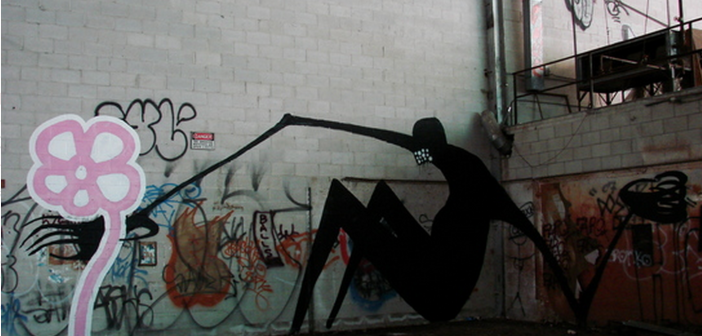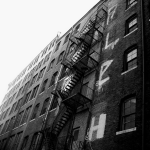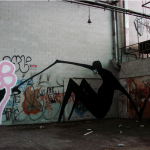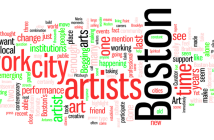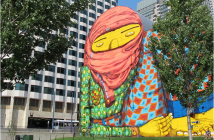Like Shepard Fairey, Alphabet Soup reuses potent images in much of his work has been active in both the street and gallery. 'Alph' differs with Fairey, however, on the articulation of the images they create. He says that Fairey's merchandising from his own street art and propagandizing for political campaigns contradicts what he stood for when he began his own campaigns.
The following is a chat Alphabet Soup and Christian Holland had about Fairey and his exhibition, "Supply and Demand," at Boston's ICA.
Christian Holland: Are you a fan of Shepard Fairey's work? Did his fame or choice to transform his street art into a salable commodity change your opinion of him?
Alphabet Soup: The OBEY campaign has obviously been an influence on a huge number of people, especially those active in street art like myself. For a while there, I was 100% into what he was doing. The use of an image as recognizable as his, and the anti corporate/consumerism theme of his early work, really got me excited. Being that his work was heavily graphic design based, and his street campaign mocked that of advertising/propaganda techniques, I guess it was inevitable, but the turning of the OBEY image into a business tool really discouraged me. In my opinion, the evolution of the OBEY imagery from street art to corporate and commercially-based work has really taken away the credibility of his street work. Years of street art based on anti-consumerism has basically become advertising for a whole slew of products.
CH: Have you seen "Supply and Demand?" What do you think?
AS: I saw "Supply and Demand" on Target free Thursdays! It's set up basically as a time line of his last 20 years of work. The first two rooms were great. His work up until about 1996, or so, was simple and perfect. His appreciation of Warhol is very apparent in his approach, and he is obviously a skilled graphic designer. If you are at all familiar with his career, you pretty much know what to expect when you walk in the door. I'm thrilled that galleries and museums are paying more attention to street art; and the fact that the ICA gave him a solo exhibition makes me very happy. With that said, and at the risk of being a hypocrite, I think his work is much more effective and attractive at the street level where it started. The larger murals at the end of the show, for example: had they been on a street corner instead of a museum wall, they would have been phenomenal, but in the environment where they were shown it looked cheap and slapped together.
CH: Why do you think Fairey is as successful as he is? Is it because of his use of the same mechanisms and devices that propagandists and advertisers use in their craft?
AS: You can credit Fairey's success to several things, but - mostly - I'd say it’s the incredible amount work he put into the streets. Graffiti writers aim to go all city, he went all planet. He made his art cheap, easily accessible and gave it to anyone who wanted it. Even if he didn't put it there himself, you can find an OBEY sticker in almost any town or city.
CH: Within the last couple years, and culminating with the Obama Hope image, Fairey seems to have shifted his tactics in image making: he used to transform propagandistic images and and now he’s using an image to make propaganda. Do you agree? If so, are you for it? against it?
AS: I completely agree. This is along the same lines as Fairey's work becoming actual advertising rather than mocking advertising. Many elements of his work are obviously borrowed from several political campaigns: the 50's Americana imagery and heavy elements of both Black Panther and Communist art and propaganda. His work has always had a play on politics - another reason why I liked it so much in the first place - but the transformation from fake to real propaganda completely ruined this for me. There are a few reasons why Shepard's use of the Obama image has damaged the credibility of his street work (Shouts to Marty and SMART CREW and ACC) but that's a different conversation. The bottom line is that once Shepard made that move, I was instantly turned off by all of his work.
CH: Is Fairey's career something that street artists aspire to?
AS: Shepard has become successful, no doubt about it, however recently it seems he's become more successful as a business man than as an artist. Street artists, and artists in general, do not necessarily aspire to be well known or make money off of what they do. The compulsive desire to create or destroy comes from the soul, and you do it just for the sake of doing it. People seem to be jumping on the band wagon in thinking that anything they put in the street is instantly art or will make it in the gallery. Street art is trendy now and people see what Fairey has done - his rags to riches success story - and now they assume that if they follow his steps, whatever they put in the street will make them famous or appreciated as an artist. His success is certainly something to aspire to but find your own way to be successful.
CH: How would you compare a graffiti artist like Banksy to Shepard Fairey?
AS: It's risky to say but think that they are in the same category. Different backgrounds, different approach, different styles etc. The one distinctive difference would be that Banksy pursued a career in fine art and Shepard went the graphic design route. They have both been very successful in doing both commercial and gallery work but Banksy has found new ways to evolve his art without compromising its original aesthetic. I feel that Shepard reworked his iconic image over and over until it worked in a commercial sense. He made it a commodity and did not stray very far from what was safe. I find it funny that Banksy and OBEY have received the most media attention as far as street artists or graffiti writers go. The two are very valuable to this culture, no question about it, but I find it strange that they have really become the household names of the graffiti culture. There are 30 plus years of graffiti writers and street artists who have done mind-blowing things and most people only know about hand-full of them.
CH: Where will Shepard Fairey be in another 20 years? What about his street art campaigns? Will they remain symbols of subversion or will his credibility as a street artist begin to erode?
AS: Shepard obviously isn't stopping. He has put in a lot of work to get where he is and has not shown any signs of slowing down - and good for him - but it will be interesting to see how he goes about doing his street work. He will survive the law suits and graffiti charges he is facing right now and go right back to what he was doing, but based on his twenty year career and where it is now I'm not expecting any surprises. Shepard Fairey's entire career is based on street art and in my opinion he has discredited years of his own work, so I'm interested to see what he comes up with now.
Images above and below of Alphabet Soup's work courtesy of Alphabet Soup.
Check Flickr and your street to see more of his work.

